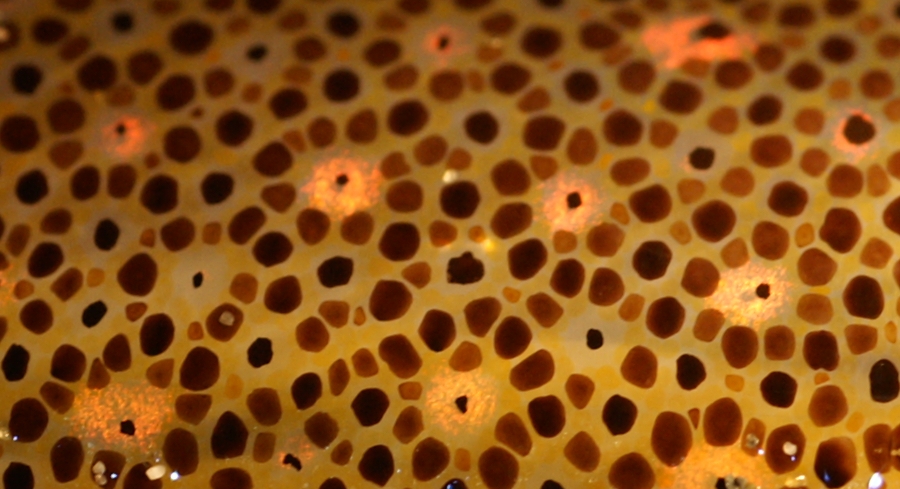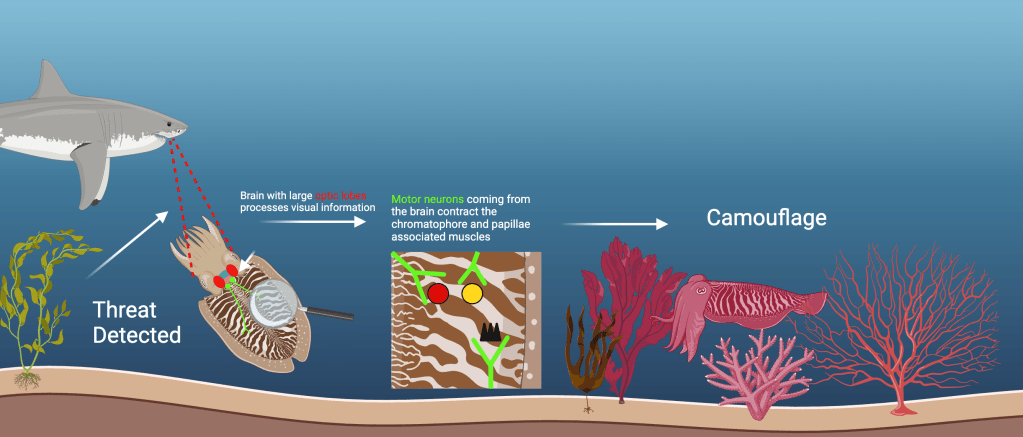April 30th, 2024
Written by: Abby Lieberman
If you are a squishy, delicious sea creature who doesn’t live in a shell, how do you avoid getting eaten? Ask a cuttlefish! Cuttlefish belong to a family of animals called cephalopods, which are a group of highly intelligent ocean creatures that also include octopuses and squids. The cuttlefish is a lesser known, but equally fascinating cousin of the octopus and squid (see Figure 1). Cuttlefish, particularly the dwarf cuttlefish, have been gaining attention from neuroscientists in recent years due to their small size, ease of raising them in laboratories, and fascinating social and camouflage behaviors. Cuttlefish are masters of disguise–they can entirely change their skin color, pattern, and even texture to match their environment in under a minute1,2. They will even try to disguise themselves in unnatural settings, such as on a checkerboard pattern.

Why, and how, do cuttlefish behave in this amazing way?
Despite our evolutionary distance from cuttlefish (our last common ancestor was about 500 million years ago3), both humans and cuttlefish are highly intelligent species. However, cuttlefish have evolved a completely separate form of intelligence that is distributed across their body (for more about this see our post about another cephalopod, the octopus). Ancient cephalopods lived inside hard external shells. However, over the course of evolution the shell disappeared in favor of a flexible body that can smoosh into small areas, making them vulnerable to vertebrate predators such as sharks4. To combat this threat, cuttlefish and other cephalopods have developed remarkable camouflaging abilities.
Masters of disguise
As cuttlefish look at their surroundings, the signals necessary to camouflage come in through their eyes and then travel to their optic (visual) lobes, which are so large that they make up 75% of the cuttlefish’s brain volume. Based on what they see, cuttlefish try to fit into the scenery around them. After the cuttlefish takes in its surroundings, special neurons in their brain called motor neurons send information to hundreds of thousands of pigment filled sacs across the cuttlefish’s body. These sacs are called chromatophores, and you can think of them like pixels on the cuttlefish’s skin (squids and octopuses also have chromatophores, see Figure 2). Motor neurons also send information to papillae, which are small sections of the skin that can be deformed to change the skin’s texture1,5. Motor neurons contract and relax the muscles associated with the papillae and chromatophores, which lets the cuttlefish create color and texture changes on its skin (see Figure 3). The amount that the muscle surrounding a chromatophore is contracted determines how much color is visible, leading to the amazing variety of colors on the cuttlefish skin6.


These drastic color and texture changing abilities are used for more than just hiding from predators. Male cuttlefish are remarkable tricksters and use their skin-changing abilities to confuse other males while they are trying to mate. Sometimes the male will display different patterns on the two sides of his body, performing courtship displays towards a receptive female on one side and deceptive female colourations towards a rival male on the other side4. Either version of this behavior lets them sneak past larger males, gaining access to the female they want to mate with (see a great video of this below):
Cuttlefish research
Many mysteries remain about the cuttlefish. To further crack their colorful code, a group of researchers at Columbia University, led by Dr. Tessa Montague, looked at the brains and bodies of dwarf cuttlefish to better understand how their bodies are organized and how their brains let them camouflage. Dr. Montague’s project led to the development of interactive 3D dwarf cuttlefish brain and body diagrams that let you explore how these remarkable animals are built (visit the CuttleBase website to explore the diagrams!)3. These diagrams will be used to guide future experiments in the lab and develop cuttlefish-friendly versions of sophisticated neuroscience technologies that are already used in experiments with mice.
Why study cuttlefish?
Cuttlefish are clearly super cool, but how can humans benefit from a better understanding of their anatomy and behavior? Why continue experiments with them? As neuroscientists, we want to figure out how our brains interpret the world around us and understand how that interpretation influences our thoughts and actions. Because cuttlefish use what they see to camouflage with their surroundings, changes in their skin color and texture let us know what they are seeing and thinking. In other words, they “wear their thoughts on their skin”7, letting us see a real time view of how their brain is interpreting the world. Because cuttlefish have this unique form of intelligence that is distributed throughout their body, studying them also gives us a window into alternative problem-solving approaches. Understanding how cuttlefish adapt rapidly to changes in their surroundings will allow us to develop new materials and technologies that are highly responsive to even small changes in the environment.
New applications
Scientists are already borrowing what they know about cephalopod camouflage to develop new technology. A recent project conducted by Dr. Cunjiang Yu at Penn State University developed an artificial, rubber skin that mimics cephalopod skin. Authors of the paper published about this project describe cephalopod skin as a “soft cognitive organ capable of elastic deformation, visualizing, stealth, and camouflaging through complex biological processing”8. The new artificial skin is made using tiny parts built from flexible materials that can “think” while being stretched or twisted, just like cuttlefish skin. Specifically, it can memorize images and remember information over time to interact and blend in with its surroundings.
Technology based on cuttlefish brains and behavior could be used to help people who need prosthetic skin or organs in the future, following burns or other injury. Development of additional smart skin technology could be used to make soft and flexible robots that help doctors perform life-saving surgeries. Humans are used to thinking of themselves as the most intelligent animal, but if we tune into the strategies of different species, we might find some answers to our problems. Next time you need to adapt to a new situation, maybe stop and ask yourself–what would a cuttlefish do?
———————————————————————————————————
For more cuttlefish fun watch the CuttleCam live stream from Dr. Tess Montague, leader of the cuttlefish brain atlas project. See if you can spot the cuttlefish performing any of the behaviors mentioned above!
References
- Montague TG, Rieth IJ, Gjerswold-Selleck S, et al. A brain atlas for the camouflaging dwarf cuttlefish, Sepia bandensis. Curr Biol. 2023;33(13):2794-2801.e3. doi:10.1016/j.cub.2023.06.007
- Nature Publishing Group. (2017). Cuttlefish change skin texture to blend in. Nature News. https://www.nature.com/articles/d41586-017-00653-3
- Cuttlebase – a scientific toolkit for the dwarf cuttlefish, sepia bandensis. https://www.cuttlebase.org/
- Amodio P, Boeckle M, Schnell AK, Ostojíc L, Fiorito G, Clayton NS. Grow Smart and Die Young: Why Did Cephalopods Evolve Intelligence?. Trends Ecol Evol. 2019;34(1):45-56. doi:10.1016/j.tree.2018.10.010
- Panetta D, Buresch K, Hanlon RT. Dynamic masquerade with morphing three-dimensional skin in cuttlefish. Biol Lett. 2017;13(3):20170070. doi:10.1098/rsbl.2017.0070
- Messenger JB. Cephalopod chromatophores: neurobiology and natural history. Biol Rev Camb Philos Soc. 2001;76(4):473-528. doi:10.1017/s1464793101005772
- Reardon, S. (2018). Cuttlefish wear their thoughts on their skin. Nature News. https://www.nature.com/articles/d41586-018-07023-7
- Shim H, Jang S, Thukral A, et al. Artificial neuromorphic cognitive skins based on distributed biaxially stretchable elastomeric synaptic transistors. Proc Natl Acad Sci U S A. 2022;119(23):e2204852119. doi:10.1073/pnas.2204852119
Cover photo by H.M. Dixon on WikiMedia Commons
Figure 1 by Hans Hillewaert on WikiMedia Commons.
Figure 2 by Minette Layne-Worthey on WikiMedia Commons.
Figure 3 created by Abby Lieberman with Biorender.com.

Leave a comment